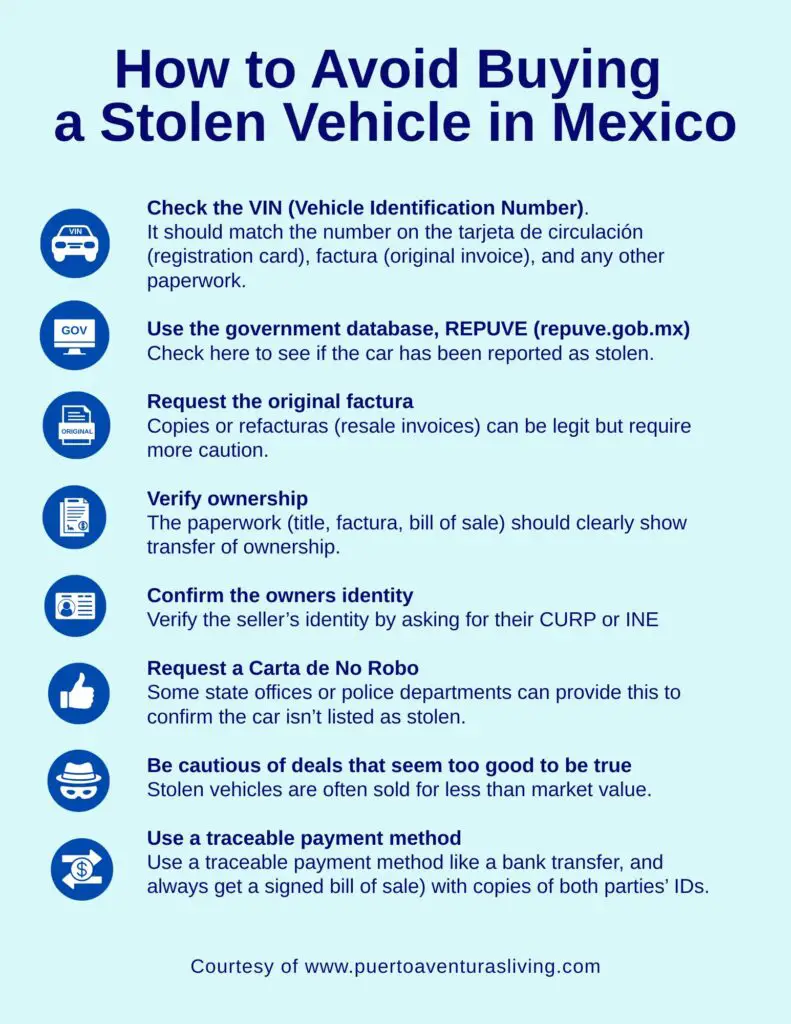Buying a car in Mexico? Here’s the checklist you didn’t know you needed — until now!
Table of Contents
Are you thinking about buying a car in Mexico? It’s an exciting move and opens up a whole new world of possibilities for adventure. But you need to be extra careful. Used car scams in Mexico are real, and the last thing you want is to lose your investment (or face legal trouble) because you missed a few critical steps.
Avoid buying a stolen car in Mexico with this easy checklist:
1. Check the VIN (Vehicle Identification Number)
When buying a used car in Mexico, always start by checking the VIN. You will find it on the dashboard, driver’s side door, and sometimes on the engine block. It must match exactly with the number listed on the tarjeta de circulación (registration card), the factura original (original invoice), and any other paperwork the seller provides. If anything doesn’t line up, walk away immediately.
2. Use the REPUVE System
Before you close any deal, check the vehicle through REPUVE (repuve.gob.mx) — the government’s car check system. You’ll need either the license plate (placas) or the VIN (NIV). If the status says “Con reporte de robo”, the car has been flagged as stolen, no matter what the seller claims. How to check if a car is stolen in Mexico starts here.
3. Always Ask for the Original Factura
The original factura is like the car’s birth certificate in Mexico. Some sellers might offer only a copy or a refactura (resale invoice), which can be legit but needs closer inspection. Ideally, you want the original document to avoid future ownership disputes.
4. Verify Ownership
Double-check that the name on the factura matches the seller’s ID. If it doesn’t, they must show legal paperwork proving a clear chain of ownership. No matching documents, no deal.
5. Confirm the Seller’s Identity
Ask for the seller’s CURP or INE (official ID) and compare it to the ownership documents. If you’re buying from a dealership, make sure it’s properly registered and licensed. A quick online search can help you spot any red flags.
6. Request a Carta de No Robo
For extra peace of mind, ask for a “carta de no robo” — a document available from some state offices or police departments that confirms the vehicle isn’t reported as stolen. It’s optional but highly recommended when buying a used car in Mexico from a private seller.
7. Be Skeptical of Bargains
If a price seems way below market value, this is a major red flag. Used car scams in Mexico often involve stolen vehicles sold fast and cheap to unsuspecting buyers. Always research fair market prices in Mexico for the make and model you’re considering.
8. Handle Payment Safely
Most private car sales in Mexico are cash deals, but whenever possible, use a traceable method like a bank transfer. Always get a signed contrato de compraventa (bill of sale) and copies of both parties’ IDs. It’s your legal protection if something goes wrong.
Buying a used car in Mexico? You can’t be too cautious.
If you are in the market for a used car, try to buy from certified or well-reviewed dealerships. They typically perform a REPUVE car check, verify paperwork, and provide a guarantee. It’s a lot safer than buying from strangers you meet on Facebook Marketplace.
Depending on where you are, your dealership options may be limited. Here on the Riviera Maya, we have plenty of dealerships but the inventory is often limited.
If you are going to buy a car from an individual or an independent dealer, be cautious, get references if you can and be sure to keep this checklist handy so you don’t forget any important steps.

Save this checklist for later and forward it to anyone car shopping in Mexico!


1 thought on “How to Avoid Buying a Stolen Car in Mexico (Checklist for 2025)”